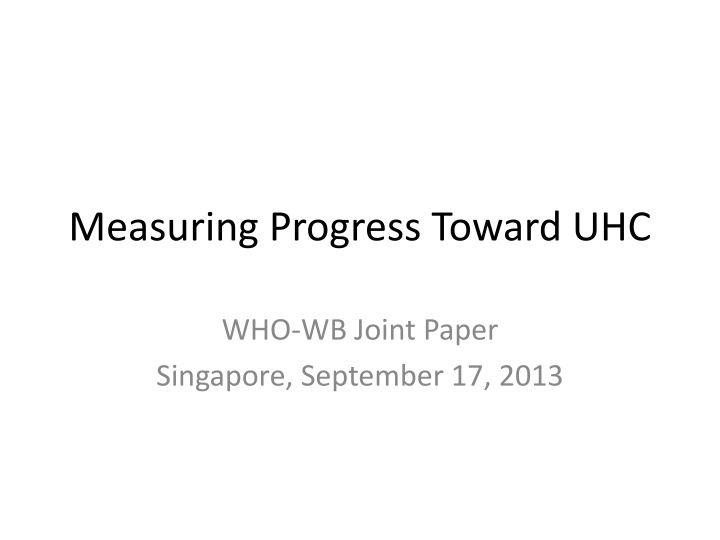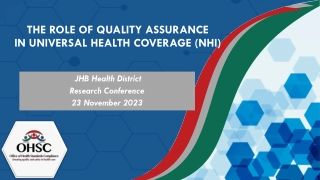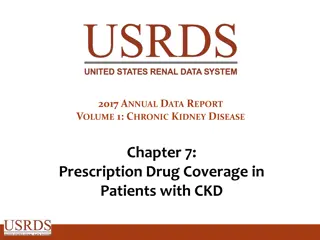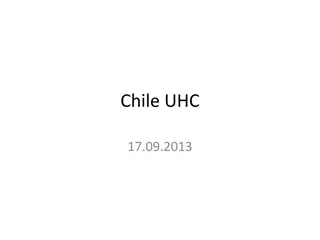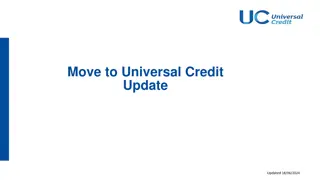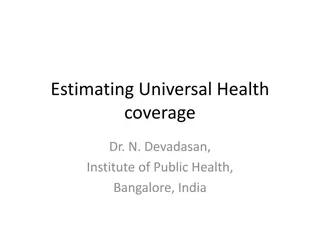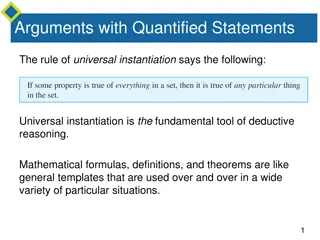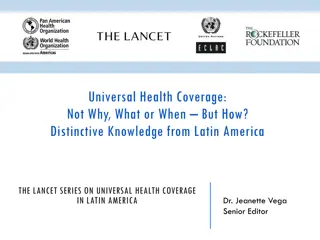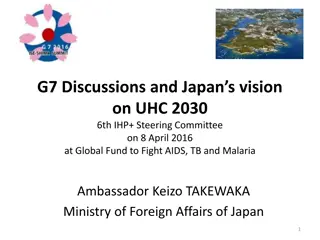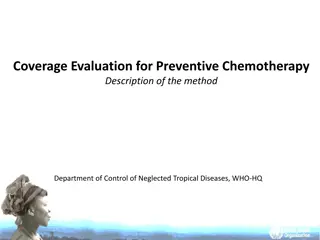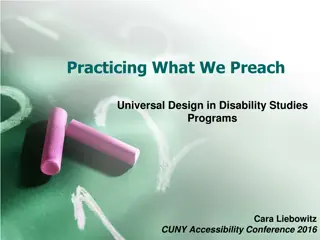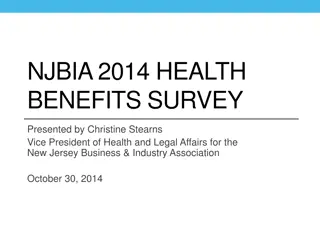Progress Toward Universal Health Coverage: Principles, Politics, and Measures
This content examines foundational principles, political aspects, and key measures for assessing progress towards Universal Health Coverage (UHC). It delves into definitions, concepts, country measures, health goals post-2015, and the evolving context of development goals.
Download Presentation

Please find below an Image/Link to download the presentation.
The content on the website is provided AS IS for your information and personal use only. It may not be sold, licensed, or shared on other websites without obtaining consent from the author.If you encounter any issues during the download, it is possible that the publisher has removed the file from their server.
You are allowed to download the files provided on this website for personal or commercial use, subject to the condition that they are used lawfully. All files are the property of their respective owners.
The content on the website is provided AS IS for your information and personal use only. It may not be sold, licensed, or shared on other websites without obtaining consent from the author.
E N D
Presentation Transcript
Measuring Progress Toward UHC WHO-WB Joint Paper Singapore, September 17, 2013
Outline Definition / Concepts Principles / Politics Methods Intervention Coverage Financial Protection Coverage Measures Next Steps
Foundational Principles Measure coverage of interventions that make a proven difference to health and wealth Measure coverage to capture the age/sex structure of the population Measure coverage to capture the structure of the health system Measure coverage to reflect social inequities
Country Measures of UHC Drawing on framework, two set of measures, and foundational principles Adapted to local context Set in the larger results framework inputs, outputs, outcomes, impacts Measures constitute important components of framework to assess progress on reforms towards UHC.
Health Goals in the Post 2015 Development Agenda DEVELOPMENT GOAL Sustainable wellbeing Wealth, gender equity, education, nutrition, environmental, security etc. Health for all HEALTH GOAL Maximizing healthy lives at all stages of life Contributions of other sectors to health Accelerate the MDG agenda Reduce the NCD burden Ensure Universal Health Coverage
The Emerging Context of the Post 2015 Development Goals Eliminating Extreme Poverty Financial protection + coverage of health services matter! Growing demand for UHC as a goal Two priority groups of health conditions MDGs infectious killers, MNCH focus Chronic Conditions and Injuries (CCIs) mainly affecting adolescents, adults + elderly Consensus on measures: MDGs, CCIs Hardwiring of equity into all targets 40% lowest part of income distribution, gender etc.
Preferred Attributes of Intervention Coverage Indicators Is a health priority based on burden of disease addressed by an intervention Is a cost-effective intervention Includes a measure of quality (sometimes referred to as effective coverage ) Credible methods exist to identify the population needing the intervention i.e. the denominator
Preferred Attributes of Intervention Coverage Indicators Credible methods exist to identify the population receiving the intervention i.e. the numerator Can be routinely measured: health management information systems or periodic household survey Equity disaggregation is possible by household wealth/income, gender, residence and other key stratifiers Measureable in comparable way across countries
Framework for measurement and monitoring of the service coverage component of Universal Health Coverage Levels of health system / service delivery Priority Health Conditions Non- personal Community based Primary (facility) Secondary (hospital) Tertiary (hospital) MNCH Coverage tracer indicators HIV/TB/ malaria & NCDs & risk factors Index Injuries Promotion, prevention, treatment, rehabilitation, palliation Coverage tracer indicators
Intervention Areas and potential tracer indicators of intervention coverage
Intervention Areas and potential tracer indicators of intervention coverage
Composite Measures of Coverage Two groups of interventions MDGs and CCIs Two broad age groups mothers/children and adults/elderly Two levels of the health system Population/ambulatory; facility-based Weighting in Aggregation Equal Unequal
Two measures of financial protection coverage 1. incidence of catastrophic out-of-pocket spending, i.e. spending exceeding a threshold of a household's 'ability-to-pay 2. the incidence of 'impoverishment' arising from out-of-pocket spending** Both measures: re-scaled to 100%: - 100% = no catastrophic expenditure - 100% = no impoverishing payments
Targets for UHC Service Coverage: 80:40 80% coverage in aggregate 80% coverage in bottom 40% of income distribution Financial Protection: 100% Zero persons/households with catastrophic payments Zero persons/households impoverished due to medical expenditure** Proxy measure: <20% THE from OOPs
Figure 2. Country Example: Service Coverage in Ghana 100 Poorest National 80 Coverage (%) 60 40 20 0
Figure 4 (a): MDGs by Regions equally and unequally weighted Coverage of Services for MDG Whole population, by regions East Asia & Pacific Europe & Central Asia Latin America & Caribbean Middle East & North Africa South Asia Sub-Saharan Africa 0 20 40 60 80 Average coverage (%) MDG tracers (unweighted) MDG tracers (weighted) Source: World Health Surveys. MDG tracers: Treatment of ARI, diarrhea, malaria and TB; Voluntary counseling and testing for HIV; Full immunization; 4+ antenatal visits; Skilled birth attendance. CCI tracers: Care within 30 mins. of traffic and non-traffic accident; Treatment of angina, arthritis, asthma, dental problems, depression, diabetes, and mental illness; Mammogram; Pap Smear; Cataract removal. Weighting: Based on relative burden of disease for each intervention considered.
Figure 4 (b): CCIs by Region equally and unequally weighted Coverage of Services for CCI Whole population, by regions East Asia & Pacific Europe & Central Asia Latin America & Caribbean Middle East & North Africa South Asia Sub-Saharan Africa 0 20 Average population coverage (%) 40 60 CCI tracers (unweighted) CCI tracers (weighted) Source: World Health Surveys. CCI tracers: Care within 30 mins. of traffic and non-traffic accident; Treatment of angina, arthritis, asthma, dental problems, depression, diabetes, and mental illness; Mammogram; Pap Smear; Cataract removal. Weighting: Based on relative burden of disease for each intervention considered.
Figure 5 (a): MDG coverage population aggregate and poorest 40% Coverage of Services for MDG By regions East Asia & Pacific Europe & Central Asia Latin America & Caribbean Middle East & North Africa South Asia Sub-Saharan Africa 0 20 40 60 80 Average population coverage (%) MDG tracers (population) MDG tracers (poorest 40%) Source: World Health Surveys. MDG tracers: Treatment of ARI, diarrhea, malaria and TB; Voluntary counseling and testing for HIV; Full immunization; 4+ antenatal visits; Skilled birth attendance.
Figure 5 (b): CCIs by Region population aggregate and poorest 40 %
Figure 6: Financial Protection Coverage by Region Financial Protection Indicators By regions East Asia & Pacific Europe & Central Asia Latin America & Caribbean Middle East & North Africa South Asia Sub-Saharan Africa 0 20 40 60 80 100 % Population Protection against catastrophic payments Protection against impoverishment Source: World Health Surveys. Prot. against catastrophic payments: % population not spending >25% of nonfood consumption on health care. Prot. against impoverishment: poverty gap ($1.25 poverty line) without OOP as a % of actual poverty gap.
Figure 7: Catastrophic Payments by Regions: 25% and 40% thresholds Financial Protection against Catastrophic Payments By regions East Asia & Pacific Europe & Central Asia Latin America & Caribbean Middle East & North Africa South Asia Sub-Saharan Africa 0 20 40 60 80 % Population 25% threshold 40% threshold Source: World Health Surveys. Prot. against catastrophic payments: % population not spending >25% or >40% of nonfood consumption on health care.
Figure 8 (a): Catastrophic Payments by Region: population aggregate and poorest 40% Financial Protection against Catastrophic Payments By regions East Asia & Pacific Europe & Central Asia Latin America & Caribbean Middle East & North Africa South Asia Sub-Saharan Africa 0 20 40 60 80 % Population Poorest 40% Population Source: World Health Surveys. Prot. against catastrophic payments: % population not spending >25% of nonfood consumption on health care.
Figure 8 (b): Impoverishing Payments by Region: population aggregate and poorest 40% Financial Protection against Impoverishment By regions East Asia & Pacific Europe & Central Asia Latin America & Caribbean Middle East & North Africa South Asia Sub-Saharan Africa 0 20 40 60 80 100 % Population Poorest 40% Population Source: World Health Surveys. Prot. against impoverishment: poverty gap ($1.25 poverty line) without OOP as a % of actual poverty gap.
Figure 9a: All UHC Measures by Region: population aggregate and poorest 40% MDG: pop Prot. against impoverishment: poorest 40% MDG: poorest 40% Prot. against impoverishment: pop Non-MDG: pop 20 40 60 Prot. against cata. payments: poorest 40% Non-MDG: poorest 40% 80 100 Prot. against cata. payments: pop eap eca lac mna sar ssa MDG: Treatment of ARI, diarrhea, malaria, and TB; voluntary counseling and testing for HIV; full immunization; 4+ antenatal visits; skilled birth attendance. Non-MDG: Care within 30 mins of traffic accident and non-traffic accident; treatment of angina, arthritis, asthma, dental problems, depression, diabetes, and mental illness; mammogram; pap smear; cataract removal. Prot. against cata. payments - % population not spending >25% of nonfood consumption on health care. Prot. against impoverishment - poverty gap (using $1.25-a-day PL) in a world without OOPs as % of actual poverty gap.
Figure 9b: All UHC Measures by Country Income Group: population aggregate and poorest 40% MDG: pop Prot. against impoverishment: poorest 40% MDG: poorest 40% Prot. against impoverishment: pop Non-MDG: pop 20 40 60 Prot. against cata. payments: poorest 40% Non-MDG: poorest 40% 80 100 Prot. against cata. payments: pop lic lmic umic hic MDG: Treatment of ARI, diarrhea, malaria, and TB; voluntary counseling and testing for HIV; full immunization; 4+ antenatal visits; skilled birth attendance. Non-MDG: Care within 30 mins of traffic accident and non-traffic accident; treatment of angina, arthritis, asthma, dental problems, depression, diabetes, and mental illness; mammogram; pap smear; cataract removal; sufficient fruit and exercise; non-smoker. Prot. against cata. payments - % population not spending >40% of nonfood consumption on health care. Prot. against impoverishment - poverty gap (using $1.25-a-day PL) in a world without OOPs as % of actual poverty gap.
Assessing the value of these measures Are they accurate, reliable? Do they measure what needs to be measured? Are they helpful to assessing the big picture with respect to UHC? Services coverage Financial protection
Indicator, Instrument Development Indicators: Service Coverage Measures of effective coverage for specific interventions self-report vs observed (clinical tests, bio-markers etc) ? capturing quality Aggregation criteria Groupings: conditions, life course, level of care Weighting: equal/unequal Financial Coverage Indicators of care not sought due to financial deterrents Indicators of services that drive financial risk Instruments: Household surveys intervention coverage beyond MNCH Expenditures that link to specific types of services Facility surveys and HMIS Identifying population numerators/denominators
